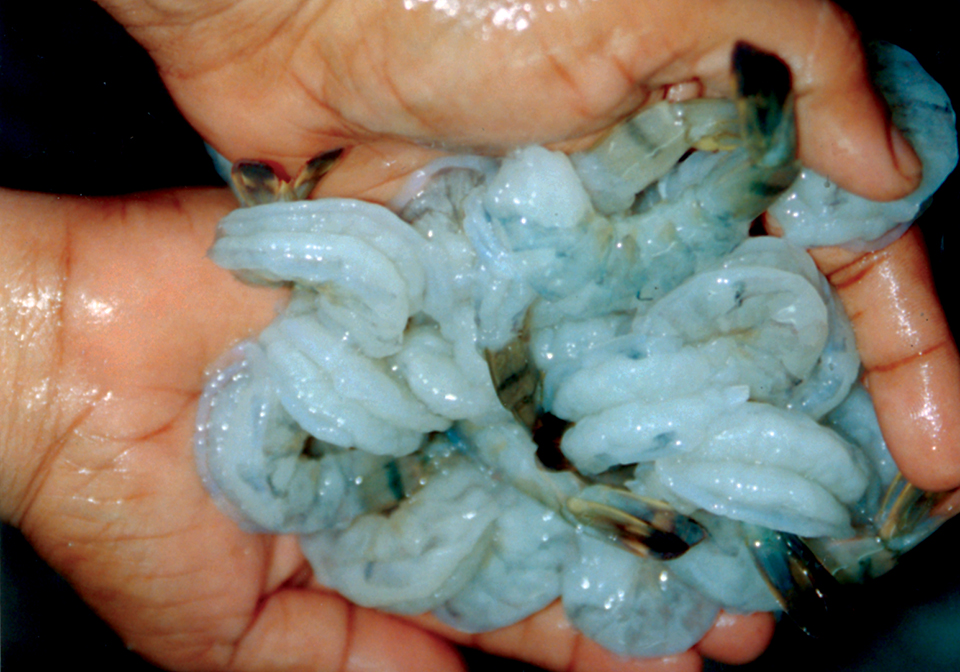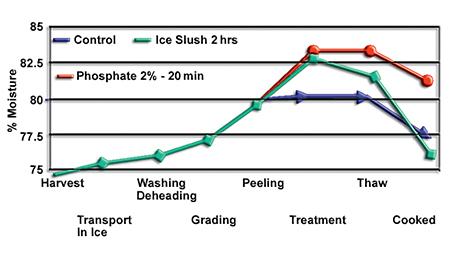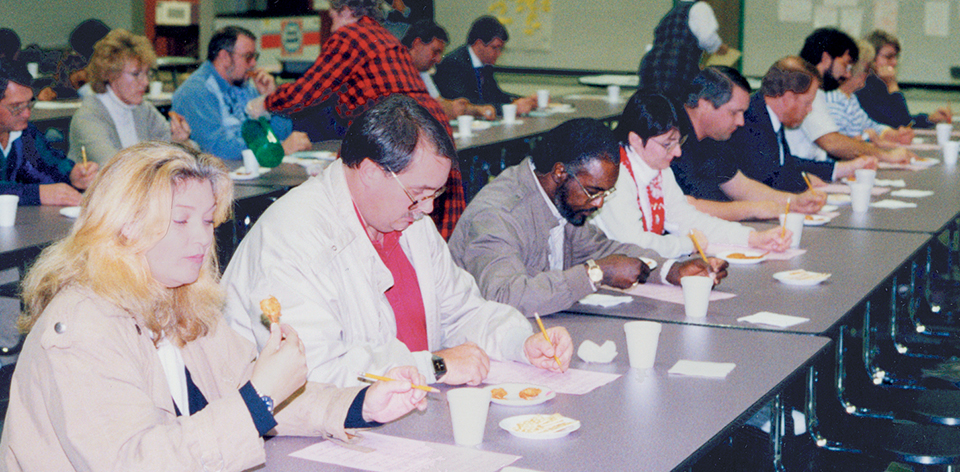Processing compounds improve taste, other product qualities

Commercial experience and research have demonstrated that phosphates can enhance sensory quality and increase consumer appeal for shrimp. Through over 10 years of research with shrimp from around the world, the Aquatic Food Products Lab at the University of Florida in Gainesville, Fla., USA, has shown that consumers prefer shrimp properly treated with phosphates. However, processors must have a clear understanding that misuse of these ingredients can result in poor appearance, poor texture, and consumer rejection.
The best approach to controlling misuse is through specifications prepared by buyers that provide product details and methods for phosphate applications. A successful phosphate treatment must be chosen carefully based on the species of shrimp, type of shrimp product (i.e., shell-on, breaded, peeled), and consumer expectations. Controls for product condition and quality must be documented during all applications.
U.S. and E.U. regulations
Phosphates are very common ingredients historically used throughout the food industry. These multipurpose ingredients are essential in shrimp processing, but are also used in the production of bakery, dairy, meat, poultry, and other popular food products.
Seafood applications are generally recognized as safe according to regulations issued by the U.S. Food and Drug Administration in Title 21, Part 182 of the 2001 Code of Federal Regulations. These regulations state the phosphates must be used in accordance with good manufacturing practices outlined in Code of Regulations document 21 CFR 110 and declared in the ingredient statements on product labels.
Similar regulations exist in Europe in accordance with European Union Directive 95/2 EC of the European Parliament and Council. The E.U. allows processors to add up to 0.5 percent of phosphates in seafood products.
Finding the right phosphate
The selection of appropriate phosphates involves quality and safety issues, preferred treatments, buyers’ specifications and monitoring.
Quality issues
Shrimp is a highly perishable product that must be maintained in cold conditions to prolong product quality and assure product safety. For these reasons, all phosphate treatments should be conducted at less than 4 degrees-C or 0 to 2 degrees-C for longer exposure times. These low temperatures should be maintained during the entire treatment.
The selected phosphates must be soluble at low temperatures and remain in solution during cold treatments. The use of a phosphate that precipitates at low temperatures can result in unpredictable yields and poor product performance.
pH and yield

The pH of the phosphate solution influences the yield. A slightly basic pH with some buffering to control the solution pH is necessary to obtain predictable yields. The pH of phosphates has also been associated with the glassy appearance of the product.
Properly treated shrimp look very similar to nontreated product, even if the processor uses a high-pH phosphate. A product with poor appearance is most likely the result of prolonged exposure to phosphates or excessive phosphate concentrations.
Also, shrimp very light in color are more prone to look overtreated. If the processor cannot maintain consistency in exposure time or the shrimp being processed is light-colored, a lower pH phosphate is recommended to maintain appearance.
Phosphate performance
Since phosphate performance can vary for different shrimp products and species, processors should determine the influence of individual phosphates on their particular shrimp. Each processor should conduct studies that compare yields after treatment, thawing and/or cooking, and prolonged frozen storage.
These comparisons should include nontreated samples and different phosphate brands. Although most phosphates have similar performance immediately after treatment, what distinguishes a good phosphate is its ability to retain moisture and product appeal during frozen storage and after thawing and cooking. Fig. 1 shows how phosphates raise moisture retention levels in shrimp.
Safety issues
The use of phosphates in treatments to maintain food quality is generally recognized as safe. The only safety issue that could be associated with such treatments is the use of phosphates that are not of food grade. In the United States, it is understood that any additive to be used in food processing should not adulterate or contaminate the product, making it unfit for human consumption. Food-grade phosphates suit these legal requirements.
Grade differences
There are two main differences between phosphates of food grade and nonfood grade (technical and agricultural grade): safety and price. When comparing the same phosphate compounds in food grade versus technical and agricultural grade, it is difficult to find significant differences in terms of functionality. However, there is a very important difference in terms of food safety. Purification and quality assurance increase the production costs of food-grade phosphates.
Food grade
Food-grade phosphates are produced under strict quality management wherein the amounts of trace contaminants such as heavy metals are limited by the purification of the phosphoric acid. Technical-grade phosphates are produced with some purification of the phosphoric acid, while agricultural-grade phosphates are produced to achieve phosphoric acid of only fertilizer grade.
Nonfood grade
Technical- and agricultural-grade phosphates are produced with no monitoring of contaminants, so the presence of heavy metals above regulatory tolerance levels is highly possible. These contaminants cannot be reduced or eliminated from food. If analysis indicates their presence in levels that violate legal standards, product detention or destruction will occur.
Preferred treatments
The proper use of phosphates in most shrimp results in better product performance and sensory benefits for consumers. Suggested levels for each product type are presented in Table 1. Lower concentrations were indistinguishable from the reference for some sensory attributes and performance, while prolonged and/or higher-concentration treatments showed signs of consumer turnoff for some sensory attributes.
Garrido, Recommended phosphate applications based on product performance, Table 1
| Product | Treatment | Target Uptake |
|---|
Product | Treatment | Target Uptake |
|---|---|---|
| Peeled shrimp, peeled and deveined shrimp | Soak in 2-4% phosphate 20 minutes to 2 hours at below 4° C | 5-8% |
| Peeled shrimp for value-added products (i.e., butterfly) | Soak in 2-4% phosphate 10-21 minutes at below 4° C | 8-10% |
Buyers’ specifications
Letting suppliers know what is wanted is the most specific and effective way to ensure the quality and safety of shrimp products. Buyers’ specifications should include the type or brand of phosphate, concentration, time of exposure, type of treatment and even maximum moisture content allowed. If buyers do not specify a brand of phosphate, it is highly recommended to include a reference for “food grade” and the chemical name of the phosphate.
Processing plants should ask phosphate suppliers to provide certificates of analysis for their phosphates. It is also good to have evidence that phosphate manufacturers have quality management systems in place.
Monitoring

Buyers can easily monitor how processing plants apply phosphate treatments by analyzing for total moisture and total phosphorus. The University of Florida has developed tentative standards for shell-on and peeled product that differentiate between treated and nontreated products. Although not a regulation, these numbers provide a tool for monitoring phosphate use.
For example, total phosphorus higher than 250 milligrams per 100 grams of meat and more than 82 percent moisture content in a sample of raw peeled shrimp is indicative of phosphate treatment. For raw shell-on shrimp, moisture content higher than 78.5 percent and total phosphorus higher than 260 milligrams per 100 grams of meat could be interpreted as treated product. These values are commonly seen in commercial shrimp, but may not be applicable to all species of shrimp.
In addition, the university developed a standardized cook retention test as a simple method to check and compare yields and weight losses after cooking. This test is an indirect measure of the use of phosphating agents.
Conclusion
The proper use of phosphates in most shrimp products provides sensory benefits to consumers and can significantly reduce moisture and weight losses. Processors should work with buyers to determine the best treatment for each situation.
No phosphate treatment is successful unless the right product is used. A good phosphate should have consistent target uptake and good moisture retention after months of storage, thawing and/or cooking. Additionally, the treatment should be effective at low concentrations, not contaminate the shrimp, and not dramatically change its appearance.
(Editor’s Note: This article was originally published in the August 2002 print edition of the Global Aquaculture Advocate.)
Now that you've finished reading the article ...
… we hope you’ll consider supporting our mission to document the evolution of the global aquaculture industry and share our vast network of contributors’ expansive knowledge every week.
By becoming a Global Seafood Alliance member, you’re ensuring that all of the pre-competitive work we do through member benefits, resources and events can continue. Individual membership costs just $50 a year. GSA individual and corporate members receive complimentary access to a series of GOAL virtual events beginning in April. Join now.
Not a GSA member? Join us.
Authors
-
Laura R. Garrido, M.S.
Aquatic Food Products Lab
University of Florida
P. O. Box 110375
Gainesville, Florida 32611-0375 USA -
Steve Otwell, Ph.D.
Aquatic Food Products Lab
University of Florida
P. O. Box 110375
Gainesville, Florida 32611-0375 USA
Tagged With
Related Posts

Aquafeeds
A look at phospholipids in aquafeeds
Phospholipids are the major constituents of cell membranes and are vital to the normal function of every cell and organ. The inclusion of phospholipids in aquafeeds ensures increased growth, better survival and stress resistance, and prevention of skeletal deformities of larval and juvenile stages of fish and shellfish species.

Health & Welfare
Asepsis key to prevent contamination in shrimp hatcheries
Maintaining biosecurity and asepsis in larval shrimp production is a key component of the production chain in Ecuador, which requires the production of 5.5 billion larvae monthly from 300-plus hatcheries.

Responsibility
Factors affecting efficiency of commercial fertilizers in aquaculture
Intensification of pond aquaculture involves the use of commercial fertilizers such as urea and triple superphosphate to stimulate phytoplankton blooms. There is no objective way of determining the ideal fertilization rate for an individual pond.

Responsibility
Inorganic fertilization of production ponds
Nitrogen and phosphorus are the most important nutrients in fertilization of both freshwater and coastal ponds. Many factors that can affect the response of ponds to fertilizers are location-specific. Aquaculture pond managers will have to figure out the best procedure for a given location or even for an individual pond.


